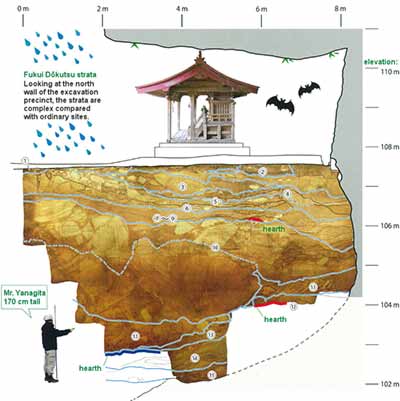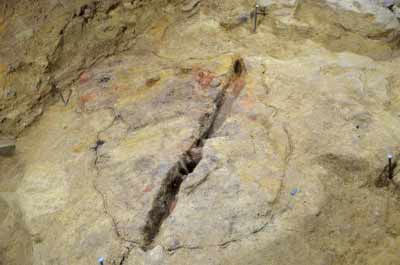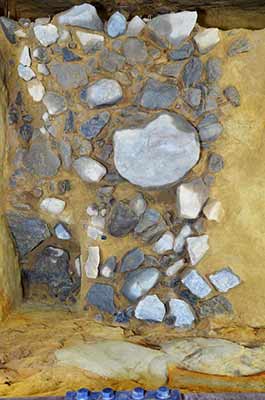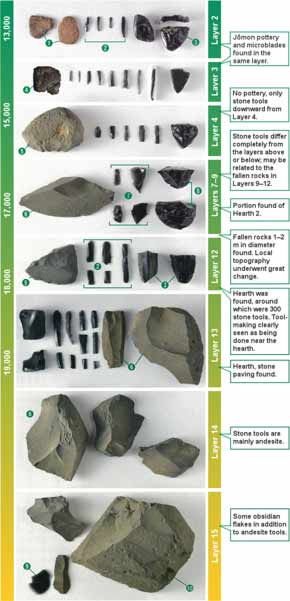Fukui Dōkutsu Historic Site:
A rock shelter that witnessed the change in culture from the Upper Paleolithic to the Jōmon periods
Fukui Dōkutsu Historic Site,
Sasebo City, Nagasaki Prefecture
Upper Paleolithic–Incipient Jōmon periods (approximately 19,000 to 13,000 years before the present)
New knowledge from the first investigation in half a century
Fukui Dōkutsu is a sandstone rock shelter formed at 110 m elevation through erosion by the Fukui river in the northern part of Nagasaki prefecture.
In the investigation of 2012–13, some 50 years after the first excavation, a layer of deposit extending 5.5 m in depth was found, and traces were ascertained of a hunting and gathering way of life pursued by people using the rock shelter as a base from the Upper Paleolithic to the Incipient Jōmon periods (19,000 to 13,000 years before the present).
Remains of four hearths detected
The strata are broadly composed of 15 layers, from at least eight different ages, and extending over 6,000 years. In addition to approximately 40,000 stone tools, consisting mainly of microblades (razor blade-like tools 2–3 cm long, made by flaking from microcores), recovered from every layer, and roughly 200 sherds of pottery, the first hearth remains (traces of fire built on the ground surface) for a rock shelter site of the Paleolithic period in Japan were confirmed.
As a result of processing the artifacts from the strata, it was seen that in contrast to Layers 2 and 3 in which Jōmon pottery and microblades were recovered together, from Layer 4 downward there were only stone tools consisting mainly of microblades. This shift in the types and compositions of utensils shows in other words the process of change from Paleolithic to Jōmon cultures, a conclusion substantiating the academic findings from 1960.
Also, two hearth remains were found from Layers 7–9, and one each from Layers 12 and 13. The locations where found were on the ground surface in the central part of the rock shelter, and 300 artifacts were recovered in the vicinity of the hearth of Layer 12. As microblades among these were scattered within a radius of 1 m of the hearth, it is clearly seen how people at the time were making tools by striking rocks while gathered around the hearth. Further, from an analysis of the carbonized materials left in the hearth remains, it has been possible to grasp broadly the environment in the area of the rock shelter at the time.
This clarification of how people utilized the rock shelter in the transition period from the Upper Paleolithic to the Jōmon periods can be regarded as a tremendous finding not just for the Japanese archipelago, but for East Asia as well. (Yanagita Yūzō)
Recovered artifacts change with the ages
The ages of all 15 layers are not clearly understood, but looking at the situation of the finds starting from the bottom, andesite stone tools are common in Layers 14 and 15. Microblades are recovered in numbers in Layer 13 (approximately 19,000 years before the present), and coming to Layer 12 (about 18,000 years ago), it can be seen from the refitted materials (previously described) how people of the Upper Paleolithic made stone tools around the hearth. But by the time of Layers 7–9 (approximately 17,000 years ago), in place of microblades completely different, irregularly shaped flakes were utilized, whereas in Layer 4 (about 16,000 years ago) microblades are again found. The reason for the disappearance of microblades is unclear, but from the presence of fallen rock in the layers there appears to have been some kind of environmental change, possibly due to a collapse of the rock shelter or other cause. Subsequently, in Layer 3 (approximately 15,000 years before the present) Jōmon pottery is first recovered, and this is thought to be the transition period from Paleolithic to Jōmon culture.
What was learned from hearths and fallen rock
As a result of analysis of carbonized materials (burnt remains from fires) and animal bone fragments left in each hearth, it was possible to grasp the broad outlines of the local environment including the presence of deciduous trees and wild boar in the vicinity of the rock shelter. Also, in addition to the large pieces of fallen rock found between Layers 9 and 12, conditions of erosion by the river were ascertained in the bottommost Layer 15, although the age is yet unconfirmed through radiocarbon dating. From these findings it was possible to reconfirm that the Fukui Dōkutsu rock shelter has reached its present form through repeated episodes of riverine erosion and bedrock collapse.







